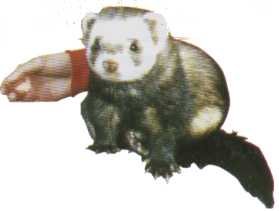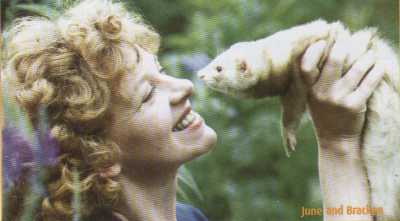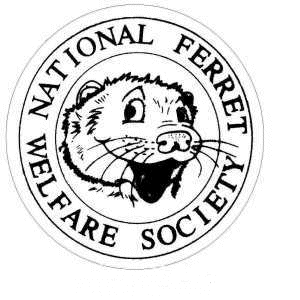On The Couch - April/May 2002
 In an exclusive new series, DR JUNE McNICHOLAS, a senior psychologist and expert on animal behaviour, opens her case notes for Ferrets First readers. Her first clinical analysis concerns Laurie X the ferret who thought he was human.
In an exclusive new series, DR JUNE McNICHOLAS, a senior psychologist and expert on animal behaviour, opens her case notes for Ferrets First readers. Her first clinical analysis concerns Laurie X the ferret who thought he was human.
In safe hands: But will Laurie learn to live with his own kind?
Picture posed by model to protect Laurie's identity
LAURIE X, a rather small three year-old entire polecat hob was handed into a rescue centre several months ago. He had been a much-loved only pet, living in the house with his lady owner, receiving a great deal of freedom and attention.
The ideal solution was to find a similar home for him as soon as possible. Few people want an entire hob as a close companion, so he was booked in for castration. It was hoped that this would also help if it was decided that he should be introduced to other ferrets.
Sadly, no one came forward to offer a home to a super-soft single house ferret. Laurie was unhappy in rescue as busy shelters tend not to be able to spend large amounts of time with an individual ferret. He was placed in foster care with six other ferrets, all cheerful, sociable, characters. The plan was to allow a few weeks for Laurie's hormone levels to subside after castration and then to gradually integrate him with the group.
However, it soon became evident that Laurie had spent so much time with humans that he was unable to relate to ferrets at all. He didn't even seem to recognise them as his own kind. His behaviour alternated between terror and aggression. He would run from them and hide, cowering and sometimes screaming with fear, or initiate an all-out attack. Althought the other ferrets showed only curiosity and tolerance at first, Laurie's strange behaviour and aggression took its toll and they began to return his aggressive advances.
Laurie came to me and my partner, Jeff, at the Coventry and Warwickshire branch of the National Ferret Welfare Society to have his behaviour assessed. He was very, very, human oriented and quickly became depressed if he was left alone. We had to find him a home, teach him socially acceptable behaviour or find some ferrets who would put up with his strangeness. Although it was the least obvious of solutions, it was the last option we eventually went for.
Why? Well, it so happened that we had a whole group of rather strange ferrets that just might offer a solution to Laurie's problem.
This group consisted of two young adult jills and their collective offspring of seven kits. These had been the subject of a combined RSPCA and social services rescue case. The two jills had been abandoned loose in the back room of a flat where they had given birth. The only human contact had been a tin of dog food thrown in through the door or the window. Seven kits grew to at least eight weeks without ever seeing a person or being handled. The group was in a very poor shape physically and mentally and took some time to rehabilitate and socialise.
The five kit hobs had grown to some of the biggest ferrets I'd ever seen and the young jill kits were pretty hefty lasses as well! All had been neutered and all were as raucous and boisterous as bunch of good natured hooligans as you could imagine.
Why on earth should these be right for Laurie?
They offered an ideal solution. The group had never interacted with any other ferrets so they wouldn't know he was acting strangly. Nor had the kits met a male ferret before, aggressive or otherwise. It was highly unlikely that they would even recognise male aggression if it came and grabbed them by the throat - as, of course, it was highly likely to! All were young, curious, playful and more to the point, indestructible! It was very unlikely that the rather small Laurie would be able to dominate the much larger hobs, docile as they were. The fact that there were nine in the group also meant that Laurie would have his work cut out if he intended to sort them all out.
The initial introduction took place in the kitchen and it was with the largest and most outgoing of the hob kits. Marty, Laurie sniffed at him cautiously. Marty bounced. Laurie then tried to grab Marty by the back of the neck. It wasn't a great success, Marty was so much bigger Laurie just slipped off his back. In any case, Marty thought it a great joke. At this point Laurie became puzzled, so he 'skunked' and hid in one of the play tubes. I brought a couple of the other hob kits in. The same happened all over again. Laurie sniffed, they all bounced. He tried to grab them; they all found it wildly entertaining. No matter what Laurie did, they treated it as a joke or an invitation to play. Nor did Laurie fare any better with the brassy, bossy jills. He retreated into a sleeping box, presumably to be alone. However, the group are so sociable and playful they obviously didn't think it healthy for anyone to be alone to brood so they ALL clambered into the box to keep him company.
Poor Laurie, the first week was rather traumatic for him. The group must have seemed totally overwhelming, although not once did they treat him with anything but bouncing and good humour. Eventually it must have dawned on Laurie that they weren't going to hurt him and that he couldn't make any impression on them anyway. He gave an experimental bounce at one of them, and that was the beginning of the settling down stage.

Today, Laurie is well integrated into the group. He still prefers human company but he is not lonely when there is no one around for him. We fuss and pet him a lot. and he and the rest of the group come in the house to play. Laurie will make an excellent PR ferret one day, maybe alongside a couple of the hob kits in his group. The kits and their mums have to catch up on learning that humans are trustworthy. Laurie, on the other hand, is learning to cut down his dependency on human company.
It seems strange that Laurie, who had too much human company, should be helped by a group of kits who had no human company.
Doesn't it show that opposites can sometimes work together!
